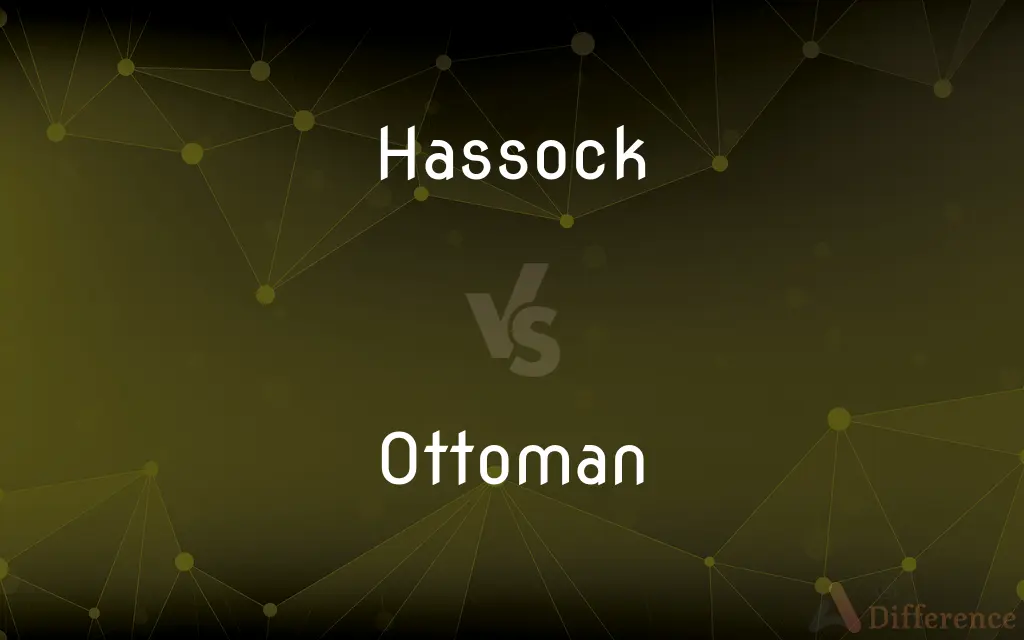Hassock vs. Ottoman — What's the Difference?
By Tayyaba Rehman — Updated on October 26, 2023
Both are types of padded furniture; a hassock is typically smaller and may be used in religious settings, while an ottoman can serve as seating or storage.

Difference Between Hassock and Ottoman
Table of Contents
ADVERTISEMENT
Key Differences
A hassock and an ottoman are both forms of furniture, primarily used for resting feet or as extra seating. While they share similar functions, their design and origins differ. The hassock has traditionally been associated with religious settings, acting as a cushion for kneeling during prayer. On the other hand, the ottoman originated from the Ottoman Empire, reflecting its design sensibilities and acting as a central piece in living spaces. Ottomans often have storage capabilities and can be larger, serving as standalone furniture.
Hassocks, being smaller and more portable, may not provide the same multifunctional benefits as an ottoman. In modern American English, the distinctions between the two have blurred, with many using the terms interchangeably.
Yet, traditionally speaking, the hassock’s association with religious practice and the ottoman’s origin from a historical empire offer unique perspectives on their roles in spaces.
Comparison Chart
Origin
Traditionally religious settings
Ottoman Empire
Size
Generally smaller
Can be larger, standalone
ADVERTISEMENT
Function
Primarily for kneeling or resting feet
Seating, footrest, sometimes storage
Design Features
Lacks storage, more portable
Often with storage, more structured
Common Usage
Sometimes used interchangeably with ottoman
Broadly recognized as a piece of furniture
Compare with Definitions
Hassock
A cushion used for kneeling in religious ceremonies.
She knelt on the hassock during the prayer.
Ottoman
A piece of furniture used primarily as a footrest.
She propped her feet up on the ottoman after a long day.
Hassock
A thick, firm cushion used as a footstool.
He placed his feet on the hassock while reading.
Ottoman
A reference to the historical Ottoman Empire.
The design of the chair was reminiscent of Ottoman architecture.
Hassock
A tufted mound of grass or vegetation.
The field was dotted with hassocks of grass.
Ottoman
A padded, upholstered seat or bench without arms or a back.
The living room had a large leather ottoman in the center.
Hassock
A small, padded seat without back or arms.
The child sat on the hassock near the fireplace.
Ottoman
A central seating piece in many living rooms.
They gathered around the ottoman to play board games.
Hassock
A portable cushion.
She carried her hassock to various rooms for comfort.
Ottoman
A Turk, especially a member of the family or tribe of Osman I.
Hassock
A thick cushion used as a footstool or for kneeling.
Ottoman
An upholstered sofa or divan without arms or a back.
Hassock
A dense clump of grass.
Ottoman
An upholstered low seat or cushioned footstool.
Hassock
A dense clump of grass or vegetation; a tussock.
Ottoman
A heavy silk or rayon fabric with a corded texture, usually used for coats and trimmings.
Hassock
A cushion used primarily in churches for kneeling on while praying. kneeler
Ottoman
Of or relating to the Ottoman Empire or its people, language, or culture.
Hassock
A thick cushion used as a seat; an ottoman or pouffe.
Ottoman
Turkish.
Hassock
A rank tuft of bog grass; a tussock.
Ottoman
(furniture) An upholstered sofa, without arms or a back, sometimes with a compartment for storing linen etc.
Hassock
A small stuffed cushion or footstool, for kneeling on in church, or for home use.
And knees and hassocks are well nigh divorced.
Ottoman
(furniture) A low stool or thick cushion used to rest the feet or as a seat.
Hassock
Thick cushion used as a seat
Ottoman
(textiles) A fabric with a pronounced ribbed or corded effect, often made of silk or a mixture of cotton and silk-like yarns.
Hassock
A cushion for kneeling on (as when praying in church)
Ottoman
Of or pertaining to the Turks; as, the Ottoman power or empire.
Ottoman
A Turk.
Ottoman
A stuffed seat without a back, originally used in Turkey.
Ottoman
A Turk (especially a Turk who is a member of the tribe of Osman I)
Ottoman
The Turkish dynasty that ruled the Ottoman Empire from the 13th century to its dissolution after World War I
Ottoman
Thick cushion used as a seat
Ottoman
A low stool to rest the feet of a seated person
Ottoman
Of or relating to the Ottoman Empire or its people or its culture
Ottoman
A substantial furniture piece that can offer storage inside.
She opened the ottoman to retrieve a blanket.
Common Curiosities
Are hassocks and ottomans the same thing?
They serve similar functions but differ in origin and design; hassocks are often smaller and related to religious settings, while ottomans are larger and may have storage.
Are hassocks portable?
Yes, given their smaller size, hassocks are generally more portable than ottomans.
Do both hassocks and ottomans come in various materials and designs?
Yes, both can be found in a variety of materials, designs, and colors to fit different décor styles.
Can a hassock be used as seating?
Yes, a hassock can serve as a padded seat, similar to an ottoman.
Are there hassocks with storage capabilities?
Traditionally, hassocks do not have storage, but modern designs might incorporate it.
Is it correct to refer to a larger piece of furniture as a hassock?
Typically, hassocks are smaller. If it's a larger piece, especially with storage, "ottoman" is more appropriate.
Is the ottoman named after the Ottoman Empire?
Yes, the ottoman as a piece of furniture traces its origins back to the Ottoman Empire.
Can ottomans provide storage?
Yes, many modern ottomans have a storage compartment within.
Can ottomans be the central piece of furniture in a living space?
Absolutely, ottomans often act as a central piece in many living rooms.
Is the term "hassock" commonly used in American English?
While recognized, "hassock" might be less commonly used than "ottoman" in contemporary American English.
What's the primary function of a hassock in a religious setting?
In religious settings, a hassock serves as a cushion for kneeling during prayer.
Can you place a tray on an ottoman to turn it into a coffee table?
Yes, many people use ottomans with trays as makeshift coffee tables.
Would you find a hassock in every American home?
Not necessarily; while hassocks are known, their presence depends on individual preferences and décor styles.
Can an ottoman serve multiple functions in a room?
Yes, an ottoman can function as seating, a footrest, and even storage.
Is the term "ottoman" understood globally?
Yes, the term "ottoman" for the furniture piece is broadly recognized in many cultures.
Share Your Discovery

Previous Comparison
Through vs. Throughout
Next Comparison
Rainfall vs. PrecipitationAuthor Spotlight
Written by
Tayyaba RehmanTayyaba Rehman is a distinguished writer, currently serving as a primary contributor to askdifference.com. As a researcher in semantics and etymology, Tayyaba's passion for the complexity of languages and their distinctions has found a perfect home on the platform. Tayyaba delves into the intricacies of language, distinguishing between commonly confused words and phrases, thereby providing clarity for readers worldwide.














































